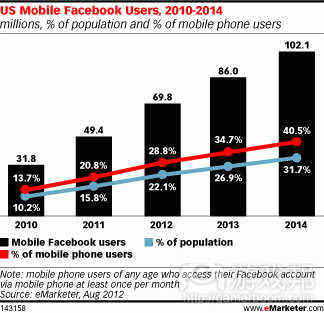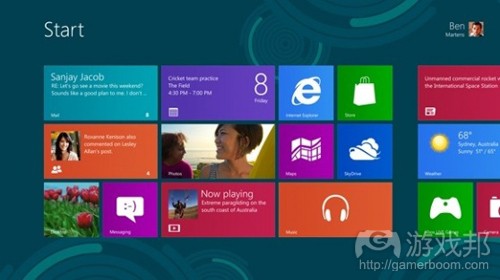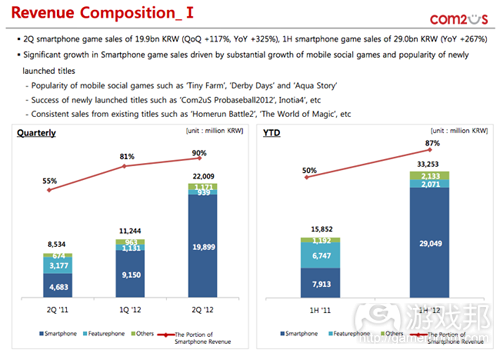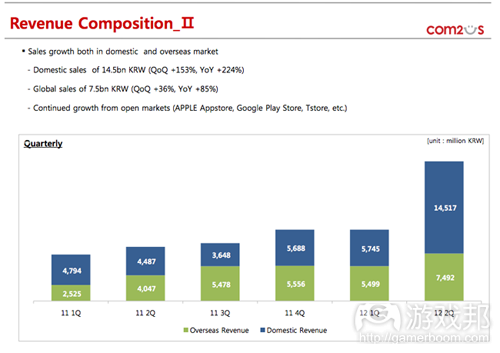每日观察:关注iPad在中国平板电脑市场份额近73%(8.9)
1)Analysys International最近报告显示,今年第二季度苹果iPad已占据全球68%平板电脑市场份额,在中国市场份额已将近73%(在中国,即使是最平价的iPad也已相当于一个普通工人10%的年均收入)。
IDC最新数据显示,苹果在2012年第二季度的iPad销量为1700万部,全球每销售10部平板电脑中就有7部是iPad。
iPad在中国销量与本土品牌联想平板电脑形成了鲜明对比,后者市场份额仅超过8%,而三星本季度在中国市场份额则下滑至3.59%。
2)eMarketer最近数据预测,今年美国将有8200万用户(占美国人口的26%)通过手机访问社交网站,预计2014年这一数据将增长至近1.17亿。
Facebook已占据85%的移动社交网络市场,其比例有增无减。预计到2014年Facebook移动社交网络市场份额将增至87.4%,覆盖近三分之二的智能手机用户。
但与此同时,移动平台的社交网络增长率则将从2011年的50%降至2014年的18%。
eMarketer指出今年将有1.16亿美国人将成为智能手机用户,其中Android用户占比43%。
预计到2014年通过手机访问社交网络的美国用户比例将达36.2%(游戏邦注:如果从移动用户的范围来看,这一比例将达46.3%);Facebook今年的移动月活跃用户将达7000万左右,不足其1.86亿北美月活跃用户的一半(Facebook全球月活跃用户为9.55亿)。
3)据Venturebeat报道,虽然微软极力宣传Windows 8是一个出色的游戏平台,但仍有些游戏开发者发出不同的声音。在上个月的Casual Connect大会上,Valve联合创始人Gabe Newell将Windows 8称为“PC领域中的大灾难”,认为这一操作系统失去了开放性。
暴雪游戏设计执行副总裁Rob Pardo也在Twiiter上发贴声称Windows 8对暴雪来说并非福音。《Minecraft》开发商Mojang创始人Markus “Notch” Persson也表示,如果微软封锁了Windows 8,这将非常不利于独立游戏及市场竞争环境,这一平台保持开放性才能够让独立开发者及大型AAA开发团队同时受益。
id Software联合创始人John Carmack认为,Windows 8并没有添加任何有趣的元素,因此他找不到支持这个平台的理由。
不过微软日前回应表示,Windows 8植入了《扫雷》和《单人纸牌》游戏,以及Xbox Windows软件,支持玩家轻松体验包括游戏在内的各种娱乐功能,这个游戏应用含有用户虚拟形象、资料、好友及玩家积分,允许玩家查看好友的虚拟形象。微软还通过Windows Dev Center指出,开发者面向这一平台开发游戏,可以获得更广泛的用户,创建可运行于多种输入设备和硬件的内容,并使用HTML5等技术制作用户会体验的东西。
4)韩国手机游戏发行商Com2uS日前发布2012年第二季度财报显示,该季度公司收益达220亿韩元(1970万美元),同比上年增长158%;净收益为60亿韩元(531万美元),同比上年增长490%。
收益比上季度的112亿韩元增长96.4%,净收益比上季度的38亿韩元增长57.8%。
Com2uS第二季度智能手机业务销售额为199亿韩元(1760万美元),同比上年增长325%,比上季度增长117%,在公司季度总收益中占比90.4%(其智能手机业务在2011年公司总收益中占比64%)。
Com2uS在韩国市场收益为145亿韩元(1280万美元),在季度总营收中占比65.9%;国际市场收益为75亿韩元(660万美元),在季度总营收中占比34.1%。
据该公司所称,Com2uS已成为韩国首家季度销售额超过200亿韩元(1770万美元)的手机游戏公司,该季度营业利润率达31%。
5)IDC最新数据显示,今年第二季度Android和iOS智能手机出货量占比85%。在该季度1.048亿部Android智能手机出货量中,三星占比44%;Android设备在该时期智能手机市场份额达68.1%。
苹果同一时期的出货量增长至2600万部,市场份额下滑1.9%。
黑莓占比4.8%,Symbian仅占比4.4%,这两者智能手机出货量分别为740万和680万。
6)Online Colleges最近发布信息图表显示,18-24岁大学生群体的智能手机用户比例持续上升,已从2011年5月的49%增长至2012年2月的67%。
47%学生使用教育类应用,有60%受言为心声是表示自己会花5英磅(7.8美元)购买辅助学习的应用程序。
(本文为游戏邦/gamerboom.com编译,拒绝任何不保留版权的转载,如需转载请联系:游戏邦)
1)The iPad has a higher market share in China than the rest of the world
John Koetsier
Apple’s market-leading iPad has great penetration globally at 68 percent market share. But it’s even bigger in China, where Analysys International says that iPad has almost 73 percent of the tablet market.
IDC’s latest numbers show that Apple owns the global tablet scene — 17 million shipped just in the second quarter of 2012. And selling almost seven out of 10 tablets sold worldwide is impressive.
But selling more than seven out of 10 in a market where even the cheapest retina iPad costs easily 10 percent of an average worker’s annual salary is unbelievable.
iPad2 and new iPad sales rising in China
In fact, that’s a 20 percent increase from the first quarter, most likely due to price cuts on earlier models. But going down from 10 percent of an average salary to 7 percent or 8 percent is not terribly significant.
The Chinese iPad numbers contrast with home-grown Lenovo, which mustered up only just over 8 percent of tablet market share, and near-neighbor Samsung, which actually lost market share in China this quarter, coming down to 3.59 percent.
Perhaps the numbers should not be that shocking. With a middle class already as large as 250 million people, there will soon be almost as many well-off Chinese as there are Americans in total.
And the 33 percent of global iPads sales that are currently recognized in the U.S. could soon be 20 percent or fewer.(source:venturebeat)
2)EMarketer: 26% Of U.S. Consumers Access Social Networks On Mobile Today, Facebook 85% Of That
Ingrid Lunden
Figures out today from eMarketer estimate that in the U.S., just under 82 million consumers, or 26% of the population, will access social networks from their phones this year, rising to nearly 117 million by 2014. But if you are a social networking startup that sees that low-penetration figure as an opportunity, be aware that at the moment Facebook has all but cornered the market, and that the market is slowing down. Facebook today accounts for 85% of all mobile social networking activity, and that proportion is only growing: eMarketer projects that Facebook will account 87.4% by 2014 — or four out of every 10 mobile users and nearly two-thirds of smartphone users.
Meanwhile, growth in social network on mobile is slowing right down, from 50% in 2011 to 18% by 2014.
Basing estimates on a variety of survey and traffic data from research firms and regulatory agencies, historical trends, company-specific data, and demographic and socioeconomic factors, eMarketer analysts found that smartphones are completely dominating social networking activity in the U.S. at the moment.
Some 95.5% of all users are checking and updating on their statuses on higher-end devices, it says. In other words, the different efforts we’ve seen from the likes of Twitter and Facebook to make their services friendly to lower-end devices are almost certainly mainly being utilized outside the U.S. Overall, in a separate piece of research, eMarketer notess that 116 million people in the U.S. will own and use a smartphone monthly this year, 43% of them Android devices.
EMarketer projects that by 2014, the percentage of people in the U.S. using social network sites on their phones will remain a minority activity, with 36.2% of users accessing sites (among the mobile population, the number is about 10 percentage points higher, at46.3%) . This shows that while the figure is growing, and indeed needs to be a consideration for companies like Facebook, PC-based access will continue to account for the majority of use in the U.S.
Indeed, eMarketer estimates that the number of Facebook mobile monthly active users this year will be around 70 million people. That works out to less than half of the 186 million MAUs that Facebook reported for June 2012 in the U.S. and Canada (Facebook’s worldwide MAU figure for June 2012 is 955 million).
Although we are still at a relatively young stage in the market, the landgrab for social mobile might at the same time be closing off: eMarketer notes that growth is slowing down by quite a lot in the next few years.
In 2011, it was growing by 50%; this year that will come down to 40%, and by 2014 “the number of mobile social networkers will increase by just 18%” although it does point out that this is “still in the healthy double digits.” It notes that mobile Facebook usage (as it dominates the space) “will have a similar growth trajectory.”(source:techcrunch)
3)Microsoft refutes developer claims that Windows 8 is bad for gaming
Jacob Lopez
While Microsoft is hard at work trying to sell the idea of Windows 8 as a great gaming platform, some developers are still not convinced.
Just last month at the Casual Connect conference, Valve cofounder Gabe Newell called the operating system a “catastrophe for everybody in the PC space.” Newell wasn’t referring only to Windows for gaming. He was talking about the operating system as a whole. Much of his worry stems from concerns of Windows losing its openness. “I think there’s a strong temptation to close the platform,” Newell said, though his comments could be clouded by Valve’s announcement today that its digital distribution service Steam will begin selling nongame software in September.
Shortly after Newell called Windows 8 a catastrophe, Blizzard executive vice president of game design Rob Pardo tweeted the quote, adding, “not awesome for Blizzard either.“
Despite the criticism from developers, Microsoft is going to make a strong push for gaming with Windows 8. For starters, it’s already chosen to brand their built-in software, such as Minesweeper and Solitaire, as Xbox Windows, tying these to their popular console gaming platform. Its mobile Windows Phone 8 OS is getting a boost in the gaming department as well.
A Microsoft spokesperson for Windows told GamesBeat why the company believes the operating system is ideal for gaming. “With Xbox on Windows 8, we created easy entry points into the types of entertainment that you’ll enjoy, including games. The Games app prominently features your avatar, profile, friends and Gamerscore and allows you to explore your friends’ avatars.”
But Brad Wardell, the CEO of Stardock, a company that specializes in Windows software and games such as Sins of a Solar Empire and Elemental: War of Magic, used words like “schizophrenic,” “obnoxious,” and “nightmare” to describe the OS in a piece he wrote back in March, “Three Killer Problems That Threaten Windows 8.” To Wardell, Microsoft doesn’t seem to know if Windows 8 is a tablet OS or a desktop OS. He feels it tries to do both, but neither very well. However, Microsoft seems to argue the benefits of Windows 8 offering multiple methods for input, such as touch and accelerometer support, and that both vital for tablet and mobile gaming.
GamesBeat reached out to Wardell for an update in light of Newell’s comments, and he e-mailed us the following statement: “I concur with Gabe. Windows 8 is trying to be all things to all people, and thus failing to be good at anything in particular. We hope to release software that will make Windows 8 more usable for desktop users, but I’d prefer if Microsoft had a more coherent strategy in the first place.”
Indie developers also fear Windows 8. Minecraft creator and founder of Mojang, Markus “Notch” Persson, had his own things to say in a recent open exchange with the Reddit community. His concern mirrors Newell’s. “If Microsoft decides to lock down Windows 8, it would be very, very bad for indie games and competition in general,” Persson said. He added that if platforms remain open, it will keep game development interesting not only for indies but for triple-A developers as well.
Many developers argue against a closed platform in which content makers would have to sell their software in the Windows 8 Store, which is essentially the App Store approach. It’s a strategy that’s worked for Apple. With this store content makers would pull in a 70 percent share of revenue while Microsoft gets the other 30. Software that pulls in a certain amount (not yet specified by Microsoft) will be upgraded to an 80 percent cut. This likely seems like a fair deal for Microsoft as they offer the means of distribution, and a storefront for developers’ products to be seen.
Speaking at QuakeCon 2012, id Software boss and cofounder John Carmack said that Windows 8 added nothing of interest and gave him no reason to consider the platform.
During this years’ annual video game tradeshow, the Electronic Entertainment Expo, GamesBeat spoke with Windows 8 project director Christopher Flores, who said, “Windows 8 is able to serve both hardcore and casual gamers, with the power you’ve come to expect from a PC.”
Microsoft also plans to offer backward compatibility for older Windows games in order to ensure that users don’t lose access to previous purchases. It was also announced during E3 that Unity Technologies will be supporting Windows 8 with their tools and game engine. According to Microsoft, it “will support specific Windows 8 features and functionality,” such as touch, accelerometer, gyroscope and Xbox Live titles. The pre-beta version is already in the hands of a limited number of developers.
The operating system will also allow users to make purchases for their Xbox 360 and queue them up for download on the console. In other words, Microsoft hopes to unify the operating system across their various platforms.
Microsoft also told us that 2K Play is already “looking forward to seeing what their games can do on Windows 8 when it ships, and one of the first titles they will be delivering for Windows 8 is GridBlock.”
We were also directed to the Windows Dev Center’s “Why develop a game for Windows” page, which argues that developers can reach a large audience, create content that works with a variety of input devices and a range of hardware, and use technologies such as HTML5 to make things people will play.(source:venturebeat)
4)Com2uS posts record quarter, sees smartphone sales increase 325% Y-o-Y to $17.6M
Kathleen De Vere
South Korea’s Com2uS is reporting record high quarterly sales and profits for Q2 2012, with revenue increasing 158 percent year-over-year to KRW 22 billion ($19.7 million), and net income increasing 490 percent year-over-year to KRW 6 billion ($5.31 million).
Com2uS’ revenue and net income also increased significantly quarter-over-quarter, with revenues up 96.4 percent over Q1’s KRW 11.2 billion and net income up 57.8 percent over Q1’s KRW 3.8 billion.
The company credited the increase in sales and profits to its growing lineup of social smartphone games and to switch to the free-to-play model, highlighting the performance of Tiny Farm, Derby Days, Monkey Battle, Aqua Story, Com2uS Pro Baseball 2012 and Inotia 4 in particular. Revenues also increased significantly year-over-year due to the existence of a Games category in the Korean iOS app store. Prior to November 2011, the Korean Game Ratings Board had prohibited games in the Korean iOS app store due to concerns about age-ratings for games.
The company’s transition to smartphone gaming has so far, been extremely successful. Com2uS’s total smartphone sales in the second quarter were were KRW 19.9 billion ($17.6 million), up 325 percent year-over year, 117 percent quarter-over-quarter, and accounting for 90.4 percent of the company’s total quarterly revenues. By comparison in 2011, smartphone sales accounted for 64 percent of Com2uS’ total annual revenues.
Com2uS’ Korean revenues were KRW 14.5 billion ($12.8 million), or 65.9 percent of total revenues. International revenues for the second quarter increased 85 percent year-over-year and 36 percent quarter-over-quarter to KRW 7.5 billion ($6.6 million), growing to 34.1 percent of the company’s total quarterly revenue.
The company also noted it is now the first Korean mobile game company to see quarterly sales in excess of KRW 20 billion ($17.7 million). Com2uS’ operating margin was 31 percent for the quarter.(source:insidemobileapps)
5)Android and iOS smartphones power 85 per cent of Q2 shipments
by Zen Terrelonge
Rival operating systems forge a new record – mostly thanks to Android.
New data from IDC says Android and iOS accounted for whopping 85 per cent of smartphone shipments in Q2.
And real diamond for Android is Samsung, which powered 44 per cent of all 104.8m Android-based smartphone shipments during the quarter, enabling the OS to nab a 68.1 per cent majority share.
As for Apple, shipments rose by 5.6m to hit 26m, but its share dipped 1.9 per cent, gobbled up by Google’s OS, and its likely shipments won’t spike until the release of the iPhone 5.
Meanwhile, BlackBerry secured just a 4.8 per cent share and Symbian bagged 4.4 per cent, with respective shipments of 7.4m and 6.8m.
Ramon Llamas, senior research analyst, IDC, said: “Android continues to fire on all cylinders.
“The market was entreated to several flagship models from Android’s handset partners, prices were well within reach to meet multiple budgetary needs, and the user experience from both Google and its handset partners boosted Android smartphones’ utility far beyond simple telephony.”(source:mobile-ent)
6)INFOGRAPHIC: Playtime’s over: How useful are smartphones for students?
by Zen Terrelonge
47 per cent say they’ve used the devices for educational purposes.
Online Colleges is behind the infographic, observing how connected apps and smartphones are affecting education.
It notes that smartphone ownership continues to rise among 18-24 year olds (college student age), growing from 49 per cent in May 2011 to 67 per cent in February 2012.
47 per cent of students have used an app for learning, while students that study on their mobiles revise 40 minutes more each week than those that don’t.(source:mobile-ent)















































 闽公网安备35020302001549号
闽公网安备35020302001549号